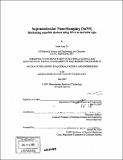Supramolecular NanoStamping (SuNS) : fabricating nano/bio devices using DNA as a movable type
Author(s)
Yu, Arum Amy
DownloadFull printable version (14.50Mb)
Alternative title
SuNS : fabricating nano/bio devices using DNA as a movable type
Other Contributors
Massachusetts Institute of Technology. Dept. of Materials Science and Engineering.
Advisor
Francesco Stellacci.
Terms of use
Metadata
Show full item recordAbstract
When a useful device is developed, it always requires a mass-production technique to industrialize it. In the era of nano/biotechnology, the development of printing techniques has not followed the speed of the inventions of novel devices. One of the main challenges is handling at the same time the resolution and the chemical complexity of these nano/bio-devices. Here a new stamping technique, Supramolecular Nano-Stamping, SuNS, capable of reproducing surfaces containing DNA-features is presented and discussed. SuNS is based on the combination of contact and supramolecular interaction between complementary DNA strands. It can replicate in a single cycle features made of DNA of arbitrary chemical complexity. SuNS is a versatile technique, masters can be fabricated with various fabrication techniques, ranging from hard lithography to soft lithography. It was used to print on multiple substrates, hard (gold, silicon), soft (Poly-methyl-methacylate or Poly-dimethyl-siloxane) or even liquid. The technical specifications of the printing process depend on the substrate material. (cont.) As an example SuNS can achieve state-of-art printing feature and point-to-point resolution (< 50 nm) when printing onto a hard substrates, or large area printing coverage (> 25 cm2) when printing onto a liquid prepolymer. In SuNS a copy has the potential to be used as another master to generate more copies. Lastly and most importantly, SuNS can replicates features composed of DNA of different sequences in a single printing cycle while keeping the chemical differences between the patterns. SuNS is still in its infancy and far from complete, it is expected that it will be extended/improved in the future.
Description
Thesis (Ph. D.)--Massachusetts Institute of Technology, Dept. of Materials Science and Engineering, 2007. Includes bibliographical references.
Date issued
2007Department
Massachusetts Institute of Technology. Department of Materials Science and EngineeringPublisher
Massachusetts Institute of Technology
Keywords
Materials Science and Engineering.